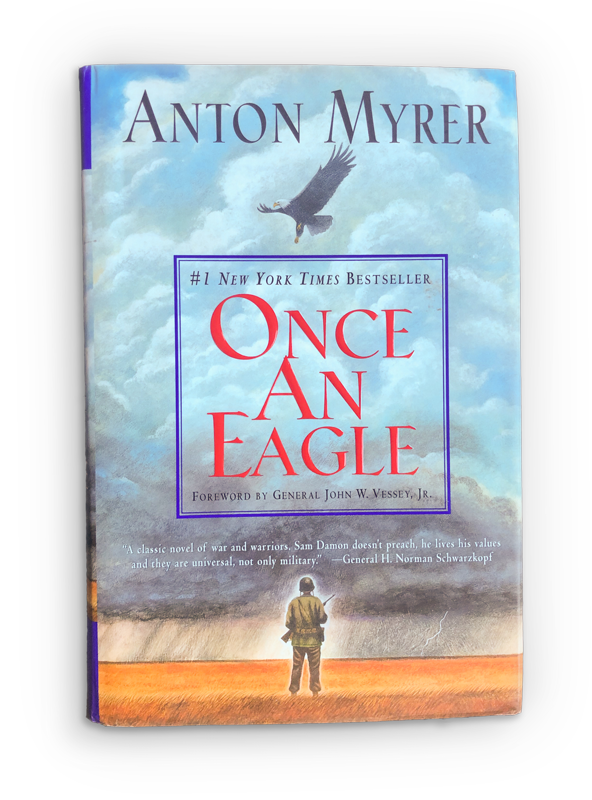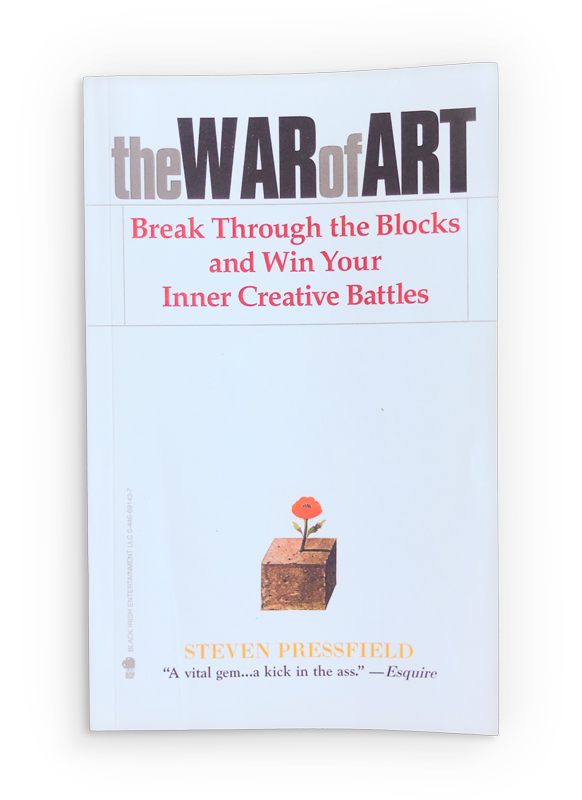JACK CARR READING LIST
OCTOBER 2019
Welcome to the New Jack Carr Reading List
Since the publication of THE TERMINAL LIST, I have been asked time and time again for a list of recommended books. Before I left the SEAL Teams, I was asked to put together a professional reading list by the Naval Special Warfare Center. I broke the list down into sections with my thoughts on why each of the sections was important for someone devoting their life to the profession of arms. I have no idea if it was ever implemented as I retired from naval service shortly thereafter. I also have a personal reading list separate and distinct from the military one. Instead of combining and releasing the lists all at once I’ll be highlighting six books a month. For those interested in the books that influenced me throughout my life, why I think they are important, and the impact they had on my development as a combat leader and writer, this is for you.
The first six books are:
- Once An Eagle by Anton Myrer
- Term Limits by Vince Flynn
- The Hero with a Thousand Faces by Joseph Campbell
- Warfighting by the United States Marine Corps
- The Great Game by Peter Hopkirk
- The War of Art by Steven Pressfield

There is nothing I like more than discussing books and reading. I look forward to sharing my thoughts about them with readers!

There is nothing I like more than discussing books and reading. I look forward to sharing my thoughts about them with readers!
Once An Eagle by Anton Myrer
Once An Eagle by Anton Myrer is my most gifted book, and if the recipient doesn’t read it, it’s so thick it can also double as a doorstop or a blunt impact weapon. I gave this book to all my junior SEAL officers to read as they began their careers and to those I’ve encountered along the way who I thought would appreciate it. I think the virtues extolled in this brilliant work are truly inspirational and that its lessons will stay with the reader throughout their lives. Once an Eagle follows Sam Damon from a high school student into WW I, WW II, and up to Vietnam. The book is remarkable in its presentation of the characteristics and attributes of a leader of warriors and men. The protagonist of the ideal soldier in Sam Damon is juxtaposed to his adversary within the ranks in Courtney Massengale, the rank climbing, political, rear echelon soldier whose very existence is a cancer within the military. Reputation is what is most important to those of us who have pursued the profession of arms, especially to those of us in the close-knit world of special operations. One of the great lessons of the book is to see to your character and your reputation will take care of itself. I would also enclose a short letter taped to the back cover to be read when they finished the book containing a few thoughts on what they had just read, not wanting to pollute their reading experience with my interpretation ahead of time. One of my favorite quotes comes from Once an Eagle. It is advice on character that a wise Sam Damon passes along to his son that I have passed on to my children as well. He says, “You can’t help what you were born and you may not have much to say about where you die, but you can and you should try to pass the days in between as a good man.” In the end that really says it all.
Term Limits by Vince Flynn
Term Limits by the legendary Vince Flynn is the groundbreaking novel that changed the genre and established Vince Flynn as the master of the modern political thriller, paving the way for a new generation of thriller writers.
It is Vince Flynn’s first novel and the only one that does not feature Mitch Rapp as the protagonist. A well thought out novel of well calculated revenge by a group with the will, means, training and experience to carry it out, Term Limits is one of those novels that convinces the reader through the art of storytelling that its central theme might one day come to fruition, and if it does, that it might not necessarily be a bad thing.
I was fortunate enough to meet Vince Flynn years ago at SHOT Show in Las Vegas, an industry event showcasing all the latest gear and weapons. He exceeded all expectations! Such a wonderful person. He was so generous with his time. I’ll never forget how he treated me. We were able to walk though SHOT together at the end of the day as it was closing down. I remember asking him if he ever worried that one day he would wake up and pick up the paper to discover that someone had used Term Limits as a blueprint to hold our elected officials accountable. I’ll never forget his response: “Every day,” he said. Rest easy, Vince. Thank you for sharing your gift with the world.
The Hero with a Thousand Faces by Joseph Campbell
“It would not be too much to say that myth is the secret opening through which the inexhaustible energies of the cosmos pour into the human cultural manifestation. Religions, philosophies, arts, the social forms of primitive and historic man, prime discoveries in science and technology, the very dreams that blister sleep, boil up from the basic, magic ring of myth.”
I was introduced to Joseph Campbell through a series of interviews he did with Bill Moyers on PBS back in 1988 called The Power of Myth. I was enamored with his grasp of history, mythology and the power of storytelling on society. It certainly didn’t hurt that George Lucas credited Campbell with influencing his development of Star Wars. I read The Hero with a Thousand Faces shortly after watching the PBS special and quickly found I could identify the hero’s journey described by Campbell in my favorite books and movies. Campbell recognized similarities in the classic hero’s journey in mythologies across cultures. The call to adventure, the reluctant hero, his journey, the attainment of knowledge from a mentor, his trials and crucible, temptation, atonement, transformation, and return all resonated with me in 1988 and continue to resonate with me today, staying at the forefront of my imagination as I write the James Reece novels. Just as they have since time immoral, those myths and legends and their modern incarnations inspired me to undergo my own formative journey in the military.
As Campbell points out from the Vedas of ancient India: “Truth is one, the sages speak of it by many names.”
Warfighting by the United States Marine Corps
In recently looking back at my well-worn copy of the U.S. Marine Corps manual, Warfighting, I noticed that almost the entire book is highlighted. There is not one wasted sentence in the entire work. If I was asked what someone should read who is about to go into combat for the first time, there is only one answer: Warfighting. Brilliant in its breakdown of the Nature, Theory, Preparation for, and Conduct of War, Warfighting should be required reading for every man and woman in uniform and for those politicians whose decisions will ultimately commit them to the fight. “Self-directed study in the art and science of war is at least equal in importance to maintaining physical conditioning and should receive at least equal time…the mind is an officer’s principal weapon.” I’d argue that it is the warrior’s principle weapon, not just the officer’s. An anomaly in the world of military manuals, Warfighting is dynamic and well written, just as effective and efficient in its use of words as it is in the actions they describe. It should be read and re-read until its principles are a part of the reader’s very being. For the platoon sergeant going back to the sandbox for the tenth time, for the junior officer about to deploy for his or her first taste of combat, and for the general advising the president, this manual on how to fight should never be far from reach. Read it. Then read it again. Talk about it. Apply its principles and crush the enemy. As it states on its opening page: “In war the chief incalculable is the human will.” – B.H. Liddell Hart
The Great Game by Peter Hopkirk
For politicians, warfighters, pundits, academics, policy advisors, scholars, writers, and citizens wondering why we’ve been at war in Afghanistan for close to twenty years – READ THIS BOOK! The Great Game is a phrase immortalized by Rudyard Kipling in Kim, his epic novel of 19th century India, though it had been in use well before Kipling introduced it into popular culture. Peter Hopkirk’s mesmerizing history of the Brittan and Russia quest for dominance in Central Asia reads like the finest thriller; battles, spies, political maneuvering, tribal culture, betrayals and heroism are all brought to life by one of the best to ever ply the trade. In the forward to his 1994 edition, Hopkirk writes a sentence just as poignant today as it was twenty-five years ago, perhaps even more so: “Almost anything could happen there, and it would take a brave, or foolish, man to forecast what. But one thing seems certain. Central Asia, for good or for ill, is back once more in the thick of the news, and looks like staying there for a long time to come.”
The War of Art by Steven Pressfield
I think it is possible to study how to do something too much, meaning at some point one must put aside the “how-to manuals” and get to work with the actual “doing” which is why there are only a few books on creativity and publishing that I recommend to aspiring authors. One of the “must reads” on that list is The War of Art by Steven Pressfield. Pressfield is the brilliant author of Gates of Fire, The Legend of Bagger Vance, Tides of War, The Afghan Campaign, among many others. He has also generously shared his wisdom through a series of books on creativity. The War of Art is required reading for anyone contemplating putting pen to paper or fingers to the keyboard. It can be read in an hour or two so there are no excuses. It is more inspiration than “how to” and its message is exceeding clear and direct; sit down and do the work.
Among the many gems Steven Pressfield shares in this masterpiece are these:
“Of any activity you do, ask yourself: If I were the last person on earth, would I still do it?”
“Our job in this lifetime is not to shape ourselves into some ideal we imagine we ought to be, but to find out who already are and become it.”
“There’s a secret that real writers know that wannabe writers don’t, and the secret is this: It’s not the writing part that’s hard. What’s hard is the sitting down to write. What keeps us from sitting down is resistance.”
That’s the key: Slay Resistance!
There is a reason the Nike slogan of “Just Do It” is still remembered by those who saw the commercials back in 1988. It really is that simple: Sit down and just do it.
In the section on Combating Resistance and Turning Pro, Pressfield quotes Telamon of Arcadia, a mercenary of the fifth century B.C.: “It is one thing to study war and another to live the warrior’s life.”
Get this book. Read it. Then put it down and get to work!







